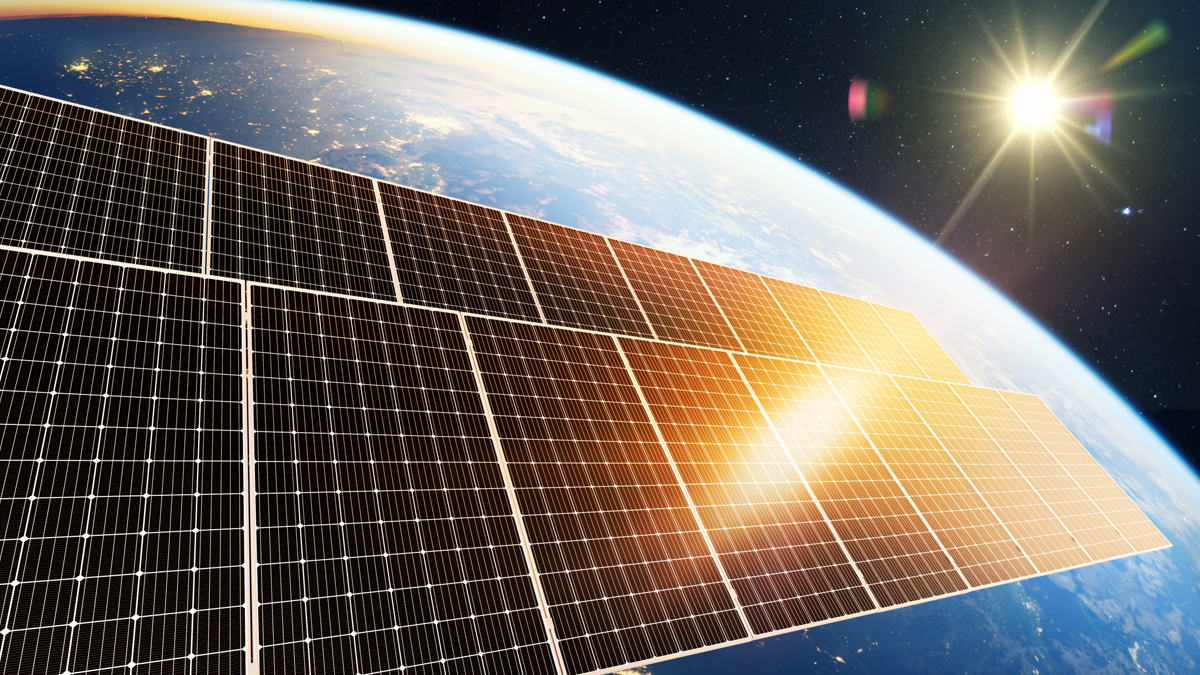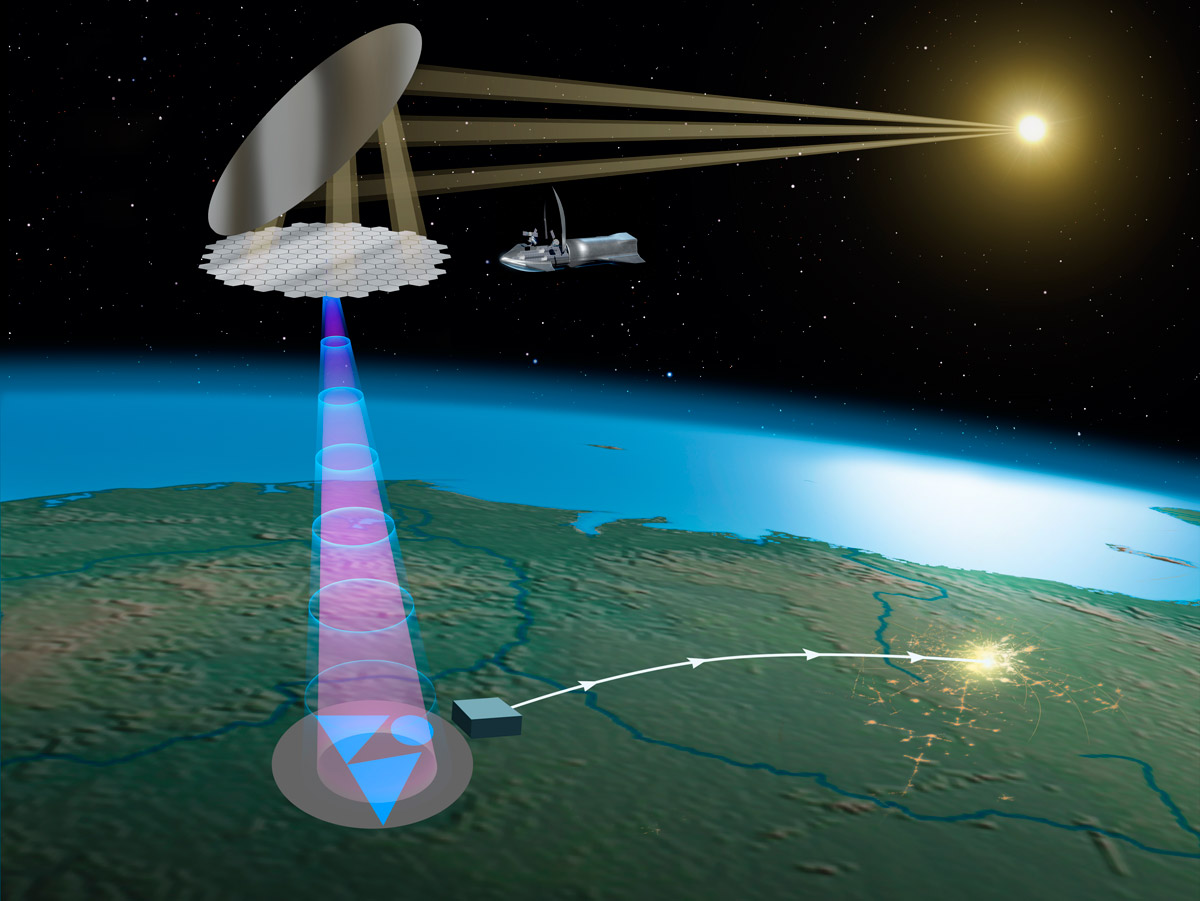
Space solar power (SSP), or power harvested from the sun via satellites and beamed to the Earth’s surface, isn’t science fiction. To gather space solar power, lightweight solar panels on satellites gather solar energy and generate electricity, which is then converted into either lasers or high-frequency radio waves and beamed to a receiving antenna at a fixed point on the ground.
Once infrastructure is in place, proponents believe that SSP could be competitive with other mainstay clean energy options like nuclear—and in a certain way, the two really aren’t that different. By putting solar arrays in space to collect energy from the sun without atmospheric interference, “We’re converting the fusion reactor we have in the neighborhood, and taking advantage of it,” said Ed Tate, CTO of Virtus Solis, an SSP start-up. Virtus Solis plans to perform an SSP demonstration in 2027.
The Perfect Moment for SSP
In January, China announced the launch of a kilometer-wide satellite solar array that could drastically reconfigure their energy sector, which is already a leader in solar. “China is a leader in operating solar farm capacity—they have over 386,000 megawatts and about 51% of the global total for solar power generation,” said Karen Jones, Senior Space Policy Analyst at Aerospace Corporation. “China is really moving forward with this, and they’re serious about solar power. They want to dominate the clean tech industry.”
Jones compared China’s planned solar array to the Three Gorges Dam, which was a hydroelectric project that completely transformed the Chinese clean energy sector and is now the world’s largest producer of hydroelectric power.
The space solar movement isn’t confined to China; it’s also getting attention throughout the U.S. and Europe. Earlier this month, Aetherflux, a renewable energy start-up, received $50M in a series A funding round to develop space solar power capabilities in LEO. The development of space solar also calls into question the relationship between the regulation of energy management and space tech. House bill HR-1368, which was introduced in February, includes language on creating a coordinated effort between NASA and the Department of Energy on space-based solar power.
And in February, an Executive Order created the National Energy Dominance Council, as part of a federal effort to build towards U.S. energy dominance. “Space solar power has the potential to be a major pillar of America’s energy strategy,” said Colby Carrier, Head of Aetherflux, DC. “The National Energy Dominance Council is a strong step in the right direction.”
SSP has been a popular idea since the 1960s, but for decades hasn’t been considered feasible. But that’s changed, as the technology required to make SSP a reality is already in use, including the crucial ability to build infrastructure in orbit. “We’re now about to move into an era of large infrastructure in space,” said Sam Adlen, co-CEO of Space Solar, a UK-based SSP start-up. “Things that were previously technically [but] not economically feasible have now become economically feasible.”
“This feels like the early days of the transcontinental railroad,” Tate said. “The engines are loud and noisy. There’s a lot of risk involved, a lot of work to be done to get the roads laid out. But once we get those things working? A lot is going to happen very quickly afterwards.”
 A schematic illustration shows how energy is gathered via solar array, beamed to the surface, and then transferred to a nearby city. (Source: Virtus Solis)
A schematic illustration shows how energy is gathered via solar array, beamed to the surface, and then transferred to a nearby city. (Source: Virtus Solis)
The Ultimate Clean Energy Solution?
“We need diversity of energy sources for resilience,” Jones said. If SSP can prove itself economically viable, it could claim a corner of the energy sector.
One economic factor is the levelized cost of energy (LCOE), or the total life cycle cost of energy over the lifetime of a project. It is radically more expensive to put the infrastructure required for SSP into orbit compared to something like terrestrial solar farms, which affects the total LCE. But SSP has other economic advantages; for example, it doesn’t invoke any land costs, which are becoming more expensive. “With beamable power, you don’t have those incredibly high transmission costs, or problems with access, because it’s dispatchable,” Jones said. “That’s what’s going to make space-based solar power practical as it matures.”
Building large-scale infrastructure in orbit might be initially expensive, but could be a better investment than similar infrastructure on the ground. “Doing something in orbit can actually be a more benign environment than dealing with rain, hail, snow, animals, dust and dirt on the ground,” Tate said.
“Doing something in orbit can actually be a more benign environment than dealing with rain, hail, snow, animals, dust and dirt on the ground,”
And these systems wouldn’t rely on increasingly fraught global supply chains. While critical minerals in China are becoming harder to access—and patterns of access are becoming more limited and complicated—beamable power from space could be a continually reliable energy source. It also has a smaller impact on the environment, making it one of the least invasive clean energies. “The nice thing about what we’re doing is it probably has the least material usage and the least long-term pollution impact,” Tate said.
Space solar power could also provide much-needed energy to satellite systems in orbit. Andrew Rush, the CEO of space infrastructure start-up Star Catcher, is working to solve the problem of the limited amount of power available in orbit. “Today’s satellites face significant power constraints that limit mission uptime, capabilities, and ultimate revenue generation for the operators,” Rush said. “A critical bottleneck in space activities that must be addressed in the near term is power generation.”
Will space solar power be on the market anytime soon? It might be sooner than you think, according to John Bucknell, CEO at Virtus Solis. “You’ll see a lot of forecasts out there that say that these systems might be viable in 2040, 2050,” he said. “But I think everyone’s going to be shocked at how soon the first commercial system is going to be up there.”
High v. Low Orbits, Microwave v. Laser
Gathering solar power far above the atmosphere and beaming it wirelessly to the ground might seem impractical or even impossible, but the technology to do it has existed for decades. “People don’t realize that we’ve been moving power with lasers and RF since the 1960s,” Tate said. “NASA was doing demonstrations out in the desert using their radar to move power.”
For space solar start-ups, one fundamental question is the method that will be used to beam solar power through the atmosphere to the ground. Aetherflux, for example, plans to build a constellation in LEO to “use lasers and optics to create a power grid in space,” Carrier said. This method has many defense use cases, such as powering “remote regions where delivering power is expensive, challenging or dangerous.” This circumvents vulnerable supply chains and damaged infrastructure during military operations in remote regions, which ultimately protects the warfighter.
Lasers have high power density, which is also useful in defense applications. “It’s really good for defense, and they can scale a little bit, but [lasers] are likely to remain defense-focused, because your conversion efficiencies are lower,” Adlen said. “You get atmospheric absorption, which means you can’t really deliver base load. And if you can’t deliver base load, it kind of drops off as to why you’d bother pursuing it, compared to other things in the energy mix.”
“The sun never sets in GEO,” Jones said. “You could dispatch power to certain areas that need more at night, or after some kind of grid failure.”
To be competitive with other energy options, several start-ups are opting to beam power via RF from higher orbits. The greatest strength of the highest orbits is also the most obvious: “the sun never sets in GEO,” Jones said. “You could dispatch power to certain areas that need more at night, or after some kind of grid failure.”
Virtus Solis plans to put a solar array in Molniya, a high elliptical orbit. With three constellations in Molniya, “you’re always overhead, and you have redundant coverage over about half of the Earth’s surface area,” Bucknell explained. Another advantage of using the Molniya orbit is that it simplifies the use of reusable rockets, which are crucial to lowering the cost of large-scale infrastructure. “These highly elliptical orbits allow a spacecraft at the peak of the orbit to slow down a little bit. It also lowers the perigree, which is the bottom of the orbit, enough for braking,” Bucknell said. “This means the rocket can land and be fully reusable.”
In the next few years, space solar power will continue to make significant strides, even as the type of problems faced by start-ups in this sector shift. “Four years ago, when we started, the objection was that we wouldn’t be able to get that amount of mass in orbit,” Tate said. “Now the primary objection is that nobody’s demonstrated that they can do assembly at a large scale.”
Crucially, entrepreneurs in SSP don’t view this as an insurmountable obstacle; it’s just a complicated problem that will eventually be solved, especially as the number of robots in space grows exponentially. “The barriers are engineering, not scientific practice,” Bucknell said. “Hard work and finance will get us there.”
Explore More:
Opening Eyes: Small Business Tackle Space Domain Awareness
How Satellite IoT is Driving Innovation in the Energy & Agriculture Industries
Using Space to Strengthen Non-Space Sectors
